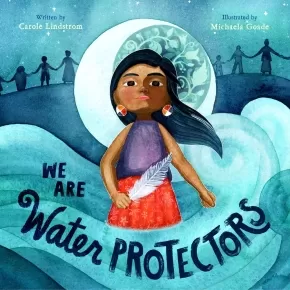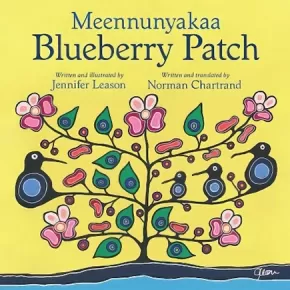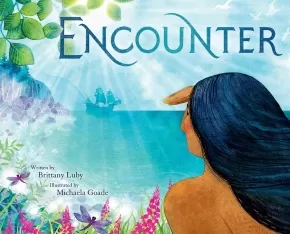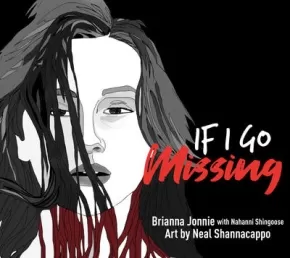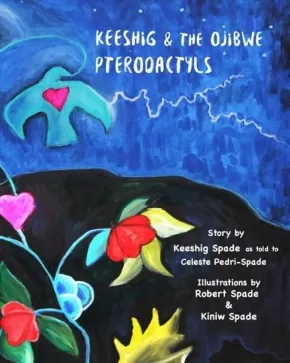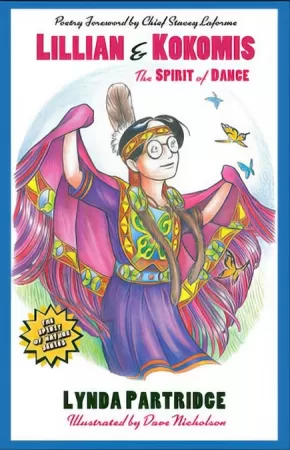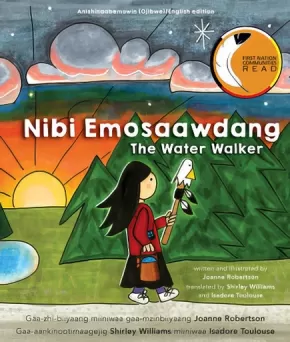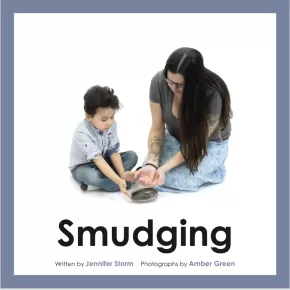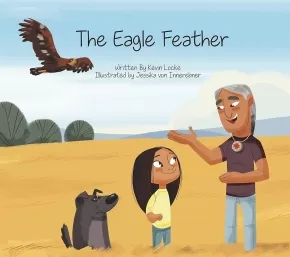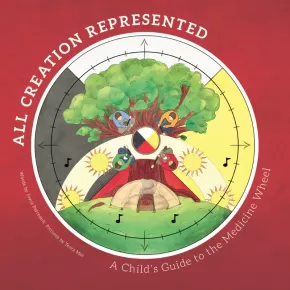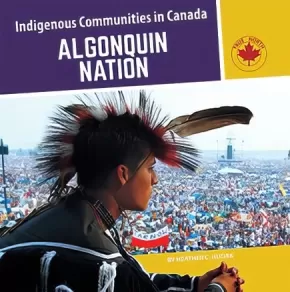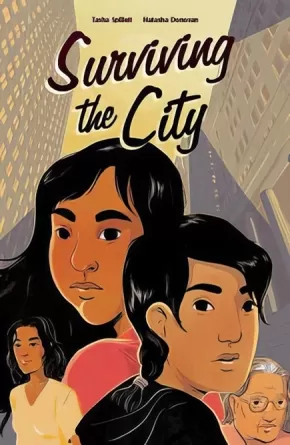
Anishinaabeg
181
-
195
of
235 Results;
Sort By
Go To
of 16
We Are Water Protectors
$24.50
Artists:
Format:
Hardcover
Text Content Territories:
Indigenous Canadian; First Nations; Anishinaabeg; Indigenous American; Native American; Anishinaabeg;
ISBN / Barcode: 9781250203557
Synopsis:
Synopsis:
Inspired by the many Indigenous-led movements across North America, Carole Lindstrom's bold and lyrical picture book We Are Water Protectors issues an urgent rallying cry to safeguarding the Earth’s water from harm and corruption.
Water is the first medicine.
It affects and connects us all . . .
When a black snake threatens to destroy the Earth and poison her people’s water, one young water protector takes a stand to defend Earth’s most sacred resource.
Featuring illustrations by Michaela Goade.
Educator Information
Recommended for ages 3 to 6.
Includes information on water protectors and the importance of water protection at the back of the book, as well as a glossary with a few words in different Indigenous languages, such as Ojibwe, Tlingit, and Lakota.
This book is available in French: Nous sommes les protecteurs de l'eau
Additional Information
40 pages | 10.00" x 10.00"
We Learn from the Sun (HC)
$22.99
Artists:
Format:
Hardcover
Text Content Territories:
Indigenous Canadian; First Nations; Anishinaabeg;
ISBN / Barcode: 9781989122396
Synopsis:
Synopsis:
This richly illustrated book by writer David Bouchard and illustrator Kristy Cameron, weaves together Woodland style paintings with a rhythmic poem about the spiritual lessons that we can learn from the Sun and the seven sacred teachings.
Educator Information
David Bouchard is a bestselling author, speaker and educator. He is Canada’s most sought after public speaker. We Learn from the Sun is an Indigenous rhyming poem based on his best selling book Seven Sacred Teachings.
An accompanying lesson plan and resource guide entitled We Learn from the Sun: Lesson Plans and Resources can be found on our site as well.
This book is available in French: On apprend du soleil.
Recommended for ages 5 to 12.
This resource is included in the Canadian Indigenous Books for Schools 2020/2021 resource list for grades K to 7 for Language Arts.
Additional Information
34 pages | 11.00" x 9.00" | 26 colour illustrations
Blueberry Patch / Meennunyakaa
$19.95
Artists:
Format:
Hardcover
Text Content Territories:
Indigenous Canadian; First Nations; Anishinaabeg; Ojibway; Saulteaux;
ISBN / Barcode: 9781926886589
Synopsis:
Synopsis:
Based in Duck Bay, Manitoba, in the 1940s, an Elder shares his experience of packing up to go out to collect blueberries, a traditional gathering that took place every summer. He describes the journey and landscape with humor and such vivid imagery that readers will see themselves there with him, boarding the trail of wagons from surrounding communities and heading east toward the blueberry patch. The Elder's stories offer a journey back in time and are complemented by images of fields of plump blueberries, tall green grass, bannock baking over an open fire, clear freshwater streams and the tents the people slept in.
Educator Information
Written in English and Anishinaabemowin. Includes a page of after-reading activities for kids at the back of the book that both test reading comprehension and encourage further inquiry and exploration.
Recommended for ages 6-8.
Themes: Manitoba, Berries, Food Sovereignty, Indigenous, Traditions, Food, Culture, Family, Community, Anishinaabe.
Includes a recipe for bannock.
Translated by Norman Chartrand.
Recommended in the Canadian Indigenous Books for Schools 2020/2021 resource list as being useful for grades K-3 in these areas: English Language Arts, Art, Math, Science, and Social Studies.
Additional Information
32 pages | 8.00" x 8.00"
Encounter
$24.99
Artists:
Format:
Hardcover
Text Content Territories:
Indigenous Canadian;
ISBN / Barcode: 9780735265813
Synopsis:
Synopsis:
Two people navigate their differences with curiosity and openness in this stunning picture book that imagines the first meeting between an Indigenous fisher and a European sailor.
Based on an actual journal entry by French explorer Jacques Cartier from his first expedition to North America in July 1534, this story imagines the first encounter between a European sailor and a Stadaconan fisher. As the two navigate their differences (language, dress, food) with curiosity, the natural world around them notes their similarities. The seagull observes their like shadows, the mosquito notes their equally appealing blood, the mouse enjoys the crumbs both people leave behind.
This story explores how encounters can create community and celebrates varying perspectives and the natural world. It is at once specific and universal. It's a story based on a primary document and historical research, but it is in equal measure beautifully imagined. It makes room for us to recognize our differences while celebrating our shared humanity.
Debut author Brittany Luby's background in social justice and history brings a breathtaking depth of insight and understanding to this story and Michaela Goade's expressive art brings equal life to the creatures and landscapes. An author's note outlines the historical context as well as situates the story in the present day.
Reviews
"Shared humanity is at the center of this Indigenous author and illustrator team’s alternative history.... Encounter’s most valuable aspect is its backmatter: Both an author’s reflection and a historical note offer crucial context to this spirited revision. “This peaceful encounter does not forgive…violent actions,” Luby notes. “Instead, it reminds us…that everyday people, like Sailor, can participate in systems that hurt others.” Without this addendum, this story runs the risk of obscuring legacies of violence rather than “learn[ing] from our history and tak[ing] the opportunity to map a better future.”
"An uplifting, #ownvoices vision for what could have been and what we are responsible for now." - Kirkus Reviews
Educator Information
Recommended for ages 3 to 7
Includes an author's reflection and historical note that provide crucial context to the events in the story.
Additional Information
40 pages | 8.50" x 10.63"
If I Go Missing (2 in stock, in reprint)
$24.95
Format:
Hardcover
Text Content Territories:
Indigenous Canadian; First Nations; Anishinaabeg; Ojibway;
ISBN / Barcode: 9781459414518
Synopsis:
Synopsis:
Combining graphic fiction and non-fiction, this young adult graphic novel serves as a window into one of the unique dangers of being an Indigenous teen in Canada today. The text of the book is derived from excerpts of a letter written to the Winnipeg Chief of Police by fourteen-year-old Brianna Jonnie — a letter that went viral and was also the basis of a documentary film. In her letter, Jonnie calls out the authorities for neglecting to immediately investigate missing Indigenous people and urges them to "not treat me as the Indigenous person I am proud to be," if she were to be reported missing.
Indigenous artist Neal Shannacappo provides the artwork for the book. Through his illustrations he imagines a situation in which a young Indigenous woman does disappear, portraying the reaction of her community, her friends, the police and media.
An author's note at the end of the book provides context for young readers about Missing and Murdered Indigenous Women and Girls in Canada.
Awards
- 2021 Indigenous Voices Awards winner for Published Graphic Novels, Comics, and Illustrated Books in any Language.
Educator Information
Recommended Ages: 12 - 18.
Recommended in the Canadian Indigenous Books for Schools 2020/2021 resource list for grades 7 to 12 for use in these areas: English Language Arts, Social Justice, and Social Studies.
This book is available in French: Si je disparais
Additional Information
64 pages | 8.50" x 9.50" | 100+ 2-colour illustrations
Keeshig and the Ojibwe Pterodactyls
$10.00
Artists:
Format:
Paperback
Text Content Territories:
Indigenous Canadian; First Nations; Anishinaabeg; Ojibway;
ISBN / Barcode: 9781928120209
Synopsis:
Synopsis:
On a hot summer day, a young Anishinabe boy visits the shores of Gitchee Gumee with his mother. Nanaboozhoo, their teacher, is before them, presenting himself as a mass of land that stretches across the horizon. As they visit, Keeshig tells his mother about what he calls "the Ojibwe pterodactyls" that live with Nanaboozhoo. He talks about their hunting and what they like to eat. At the end of the story, Keeshig surprises his mom by sharing that the Ojibwe pterodactyls are indeed the thunderbirds and that they are the heartbeat of Nanaboozhoo. Keeshig's mom is so happy and grateful to hear his story and gives him a big hug, letting him know that he is her heart.
Educator Information
Recommended Ages: 3 - 7
Keeshig's story, transcribed by his mother, is accompanied by stunningly beautiful colour illustrations by his father, Robert Spade, and his brother, Kiniw Spade. This remarkably beautiful children's picture book is a true family effort! Could be used to encourage children to write, illustrate, and share/tell their own stories!
Recommended in the Canadian Indigenous Books for Schools 2020/2021 resource list for grades K-1 in the area of English Language Arts.
Additional Information
22 pages
Lillian and Kokomis: The Spirit of Dance
$17.95
Artists:
Format:
Paperback
Text Content Territories:
Indigenous Canadian;
ISBN / Barcode: 9781988824277
Synopsis:
Synopsis:
Lillian is a girl of mixed Indigenous and white ancestry who has been shuffled from foster home to foster home as long as she can remember. At school, she doesn’t feel like she fits in with the white kids and doesn’t fit in with the Indigenous kids either. She finds happiness and a sense of belonging from a surprising spirit that returns her to traditional ways.
Reviews
“I love this book. I think everyone, not just children should read it. With gentle empathy and joyous hope, Lynda Partridge paints the heartbreaking realities lived by far too many young people, while simultaneously generating optimism. She describes what is possible when we provide opportunities for generations to heal and lead us forward. The possibilities are both tremendous and endless.” - Senator Kim Pate, Senate of Canada
“Lillian has much to teach children and adults alike on the experience of utter vulnerability, resistance, and the art of the wise-child survival.” — Pamela Johnson, PhD Psychology
“A wonderful story of courage, inner strength and resilience as told through the eyes and mind of a child. Through this story of early adversity rises a person of character and wisdom who now shares her extraordinary understanding of finding a place in this world for the benefit of others”. - Leo Massi, MSW, RSW. Executive Director, H-N REACH.
“This story is from the spirit and is a message for all of our First Nations relatives that it is now time to rise up and take this responsibility back to being natural helpers, and to nurture our children who are struggling.”— Robin Decontie, MSW, Algonquin Anishinabekwe Director, Kitigan Zibi Health and Social Services
Educator & Series Information
This book is part of the Indigenous Spirit of Nature Series. It is also the first book in the Lillian Mystery series.
Foreword Poems by Chief R. Stacey Laforme.
Recommended ages: 7 to 12.
Recommended in the Canadian Indigenous Books for Schools 2019-2020 resource list as being useful for grades 6-8 for English Language Arts.
Additional Information
90 pages | 8.50" x 5.50" | 18 b&w illustrations
Nibi a soif, très soif
$18.99
Format:
Hardcover
Text Content Territories:
Indigenous Canadian; First Nations; Anishinaabeg;
ISBN / Barcode: 9781443107907
Synopsis:
Synopsis:
Nibi (dont le nom signifie « eau 7; dans la langue anishinaabe) est une jeune fille autochtone à la recherche d'eau potable. En dépit des nombreux obstacles auxquels elle fait face, elle provoque d'importants changements dans son entourage! Bientôt, grâce à sa détermination et à son énergie contagieuse, tous les membres de sa communauté ont accès à de l'eau de qualité.
Cet album parfait pour la lecture à voix haute démontre que, même lorsqu'un problème semble trop gros à affronter, les efforts de chacun d'entre nous comptent! Parents et enfants seront inspirés par le texte empreint d'espoir de l'auteure Sunshine Tenasco et par les illustrations à couper le souffle de Chief Lady Bird, qui évoquent la force et la résilience.
Educator Information
Recommended for ages 4-8.
Features of this book include:
- An upbeat story about the importance of clean water.
- Encourages discussion on other environmental issues.
- Author and illustrator are both active in youth outreach and education in their communities.
- Models a way children can bring about change —demonstrating that though young, they are not powerless.
This resource is also available in English: Nibi's Water Song.
This resource is also available in English and Anishinabemowin: Nibi nigomon/Nibi's Water Song
Additional Information
32 pages
Nibi Emosaawdang / The Water Walker
$14.95
Artists:
Format:
Paperback
Text Content Territories:
Indigenous Canadian; First Nations; Anishinaabeg; Ojibway;
ISBN / Barcode: 9781772601008
Synopsis:
Synopsis:
The dual language edition, in Anishinaabemowin (Ojibwe) and English, of the award-winning story of a determined Ojibwe Nokomis (Grandmother) Josephine-ba Mandamin and her great love for Nibi (water). Nokomis walked to raise awareness of our need to protect Nibi for future generations, and for all life on the planet. She, along with other women, men, and youth, have walked around all the Great Lakes from the four salt waters, or oceans, to Lake Superior. The walks are full of challenges, and by her example Josephine-ba invites us all to take up our responsibility to protect our water, the giver of life, and to protect our planet for all generations.
Educator Information
This is the dual-language edition, in Anishinaabemowin (Ojibwe) and English, of The Water Walker.
Recommended for ages 6-9.
This dual-language edition contains a note on the book's translation into Anishinaabemowin by Shirley Williams -- a fellow water walker -- and Isadore Toulouse, both of whom are from Josephine-ba's home community of Wiikwemkoong Unceded First Nation. The translations draw special meaning from the fact that both Shirley and Nokomis were sent to residential school, where they were forbidden from speaking their language. Nokomis was able to read the translation before her passing, and took great joy in the fact that this book would now be shared in Anishinaabemowin.
This book is available in English: The Water Walker
This book is available in French in June 2021: Nokomis et la marche pour l'eau
Additional Information
40 pages | 8.50" x 7.00"
Nibi's Water Song
$19.99
Format:
Hardcover
Text Content Territories:
Indigenous Canadian; First Nations; Anishinaabeg;
ISBN / Barcode: 9781443107891
Synopsis:
Synopsis:
Determination, teamwork, and perseverance together bring clean water for Nibi and all her friends.
Nibi is the Anishinaabemowin word for water. In Nibi's Water Song, an Indigenous girl is on the search for clean water to drink. Though she is faced with repeated obstacles, Nibi's joyful and determined energy becomes a catalyst for change and action as her community, and then in widening circles the country and government, rally around her to make clean drinking water available for all. In a story perfectly levelled for young readers, there is a strong underlying message that even when a problem seems too large to face, every bit that everyone does helps. And inaction in the face of a wrong is not an option.
Sunshine Tenasco, an Anishinabeg activist for clean water, has an amazing optimistic spirit that shines through her writing. The hopeful tone and lyrical read-aloud quality of this gentle allegorical tale open the door to conversations and action aimed at young children, whether they are on a reserve that does not have clean water or they are living with access to clean water. Chief Lady Bird's stunning, original artwork carries through the themes of strength, hope, and resilience in an incredible collaboration of talent.
Educator Information
Recommended for ages 4-8.
Features of this book include:
- An upbeat story about the importance of clean water.
- Encourages discussion on other environmental issues.
- Author and illustrator are both active in youth outreach and education in their communities.
- Models a way children can bring about change —demonstrating that though young, they are not powerless.
This resource is also available in French: Nibi a soif, très soif
This resource is available in a dual-language format of English and Anishinabemowin: Nibi nigomon/Nibi's Water Song
Additional Information
32 pages
Smudging
$10.00
Artists:
Format:
Paperback
Text Content Territories:
Indigenous Canadian;
ISBN / Barcode: 9781927849637
Synopsis:
Synopsis:
In this story, River and his Auntie demonstrate how to smudge and share why smudging is important.
Educator Information
This book is ideal for reader level K-3.
The Eagle Feather
$11.95
Artists:
Format:
Hardcover
Text Content Territories:
Indigenous American; Native American; Sioux; Lakota; Indigenous Canadian; First Nations; Sioux; Lakota;
ISBN / Barcode: 9781989122228
Synopsis:
Synopsis:
When we look up to the sky and see a beautiful eagle soaring by, we may stop to appreciate its graceful sight, but, as Kevin Locke explains, eagles also have powerful teachings to offer. In this book, Kevin shares with us that each feather on the eagle's wing represents a virtue that we can all learn from.
Educator Information
This book is an adaptation of the book Dawn Flight for a younger audience (ages 4-6). Explores Indigenous ways of knowing and being.
A page at the back of the book includes a few words in Lakota.
Suggested for Ages 4-6.
Recommended in the Canadian Indigenous Books for Schools 2020/2021 resource list as being useful for grades K-2 in this area: Social Studies.
This book is available in French: La plume d'aigle
Additional Information
26 pages | 9.00" x 8.00"
All Creation Represented: A Child's Guide to the Medicine Wheel
$16.95
Artists:
Format:
Paperback
Text Content Territories:
Indigenous Canadian; First Nations; Anishinaabeg; Ojibway;
ISBN / Barcode: 9780995012714
Synopsis:
Synopsis:
All Creation Represented is a child’s guide to the Medicine Wheel. Told from an authentic perspective of an Anishinaabe / Ojibwe knowledge holder, Joyce Perreault skillfully weaves together traditional teachings with modern educational goals, making this book an excellent resource for children of all ages.
The Medicine Wheel is a foundation of teaching and learning that shows how different parts of life are connected and balanced. Many generations of Indigenous cultures have understood the world through Medicine Wheel teachings. The Medicine Wheel offers holistic and relational ways of understanding the self, the family, the community, the natural and spiritual world. The book introduces the concept of a Medicine Wheel, highlighting the significance of the associated ancestral teachings as it discusses various aspects of human well-being, the physical world, and Indigenous culture. This book is designed as an education resource and embodies First Peoples Principles of Learning.
Learn the Ojibwe words that are represented by various aspects of the Medicine Wheel with a glossary at the back of the book, and explore a way of looking at the world that is holistic, sacred, and powerful. All Creation Represented will help readers consider the wisdom and knowledge of the First Peoples who used the Medicine Wheel to teach about and understand the world around them.
Educator Information
This book is designed as an education resource and embodies First Peoples Principles of Learning.
Additional Informaiton
32 pages | 8.25" x 8.25"
Indigenous Communities in Canada: Algonquin Nation (5 in Stock)
$14.95
Format:
Paperback
Text Content Territories:
Indigenous Canadian; First Nations; Anishinaabeg; Algonquin;
ISBN / Barcode: 9781773083827
Synopsis:
Synopsis:
A book about the Algonquin Nation.
Educator & Series Information
This book is part of the Indigenous Communities in Canada series.
Additional Information
24 Pages
Surviving the City Vol. 1
$21.95
Artists:
Format:
Paperback
Text Content Territories:
Indigenous Canadian; First Nations; Cree (Nehiyawak); Anishinaabeg;
ISBN / Barcode: 9781553797562
Synopsis:
Synopsis:
Tasha Spillett’s graphic novel debut, Surviving the City, is a story about womanhood, friendship, colonialism, and the anguish of a missing loved one.
Miikwan and Dez are best friends. Miikwan is Anishinaabe; Dez is Inninew. Together, the teens navigate the challenges of growing up in an urban landscape – they’re so close, they even completed their Berry Fast together. However, when Dez’s grandmother becomes too sick, Dez is told she can’t stay with her anymore. With the threat of a group home looming, Dez can’t bring herself to go home and disappears. Miikwan is devastated, and the wound of her missing mother resurfaces. Will Dez’s community find her before it’s too late? Will Miikwan be able to cope if they don’t?
Awards
- Winner of the 2019 Indigenous Voices Award for Works in an Alternative Format
- Co-winner of the Eileen McTavish Sykes Award for Best First Book by a Manitoba Author
- Winner of the Manuela Dias Design and Illustration Award, Graphic Novel category
Educator & Series Information
Recommended Grades: 7-12.
This graphic novel is part of the Surviving the City series, which is also part of the Debwe Series.
The Surviving the City series includes these titles:
- Surviving the City
- From the Roots Up
- We Are the Medicine
Recommended in the Canadian Indigenous Books for Schools 2019-2020 resource list for grades 10 to 12 for English Language Arts and Social Studies.
This book could be triggering for some readers as it contains mature content and focuses on issues such as Missing and Murdered Indigenous Women and Girls.
A Teacher Guide is available: Surviving the City Teacher Guide: Exploring Identity, Allyship, and Social Action for Meaningful Change in Grades 7-12
Additional Information
56 pages | 6.50" x 10.00"
Sort By
Go To
of 16

